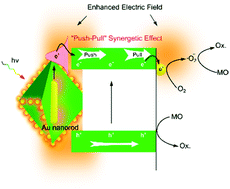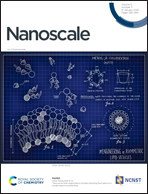An LSPR-based “push–pull” synergetic effect for the enhanced photocatalytic performance of a gold nanorod@cuprous oxide-gold nanoparticle ternary composite†
Abstract
As promising photocatalysts, nano-sized Cu2O particles suffer from severe charge recombination and insufficient light absorption, resulting in their unsatisfactory photocatalytic performance. Herein, we have designed a core–shell structured Au nanorod@octahedron Cu2O with preferentially edge-loaded Au nanoparticles (Au(R)@Cu2O–Au(P)) for an efficient photocatalytic degradation reaction. A “push–pull” synergetic effect of Au(R) and Au(P) was found to improve the transfer and separation of charge carriers from the bulk to the surface of Cu2O. Furthermore, the light beyond Cu2O particles’ absorption range can penetrate the shell (Cu2O) and for being utilized by the Au(R) core via its localized surface plasmon resonance effect (LSPR) to inject hot electrons into the conduction band of Cu2O for photocatalytic reactions. Moreover, the investigation of the size effect of Au(R)@Cu2O–Au(P) reveals that both the short charge transfer distance and the more efficient charge transfer have contributed to its enhanced photocatalytic activity.



 Please wait while we load your content...
Please wait while we load your content...